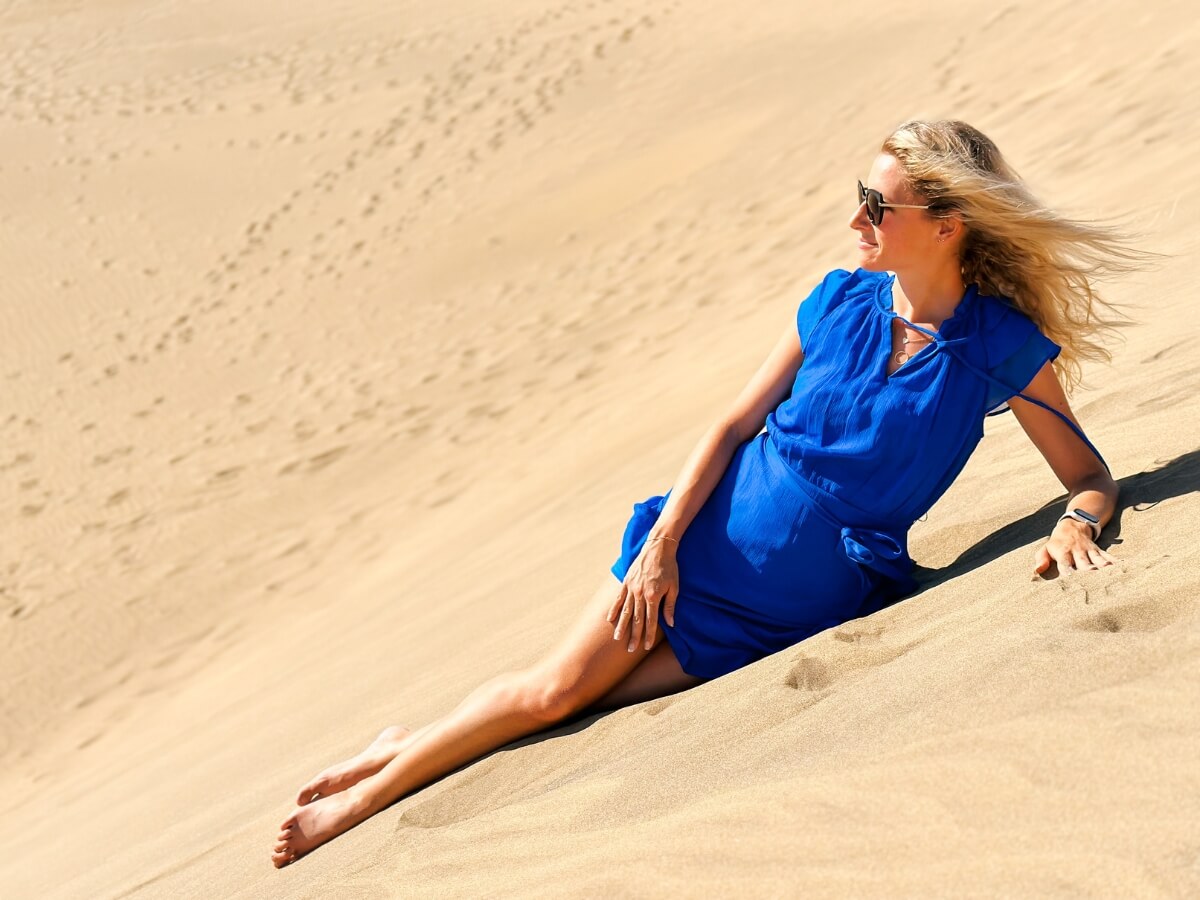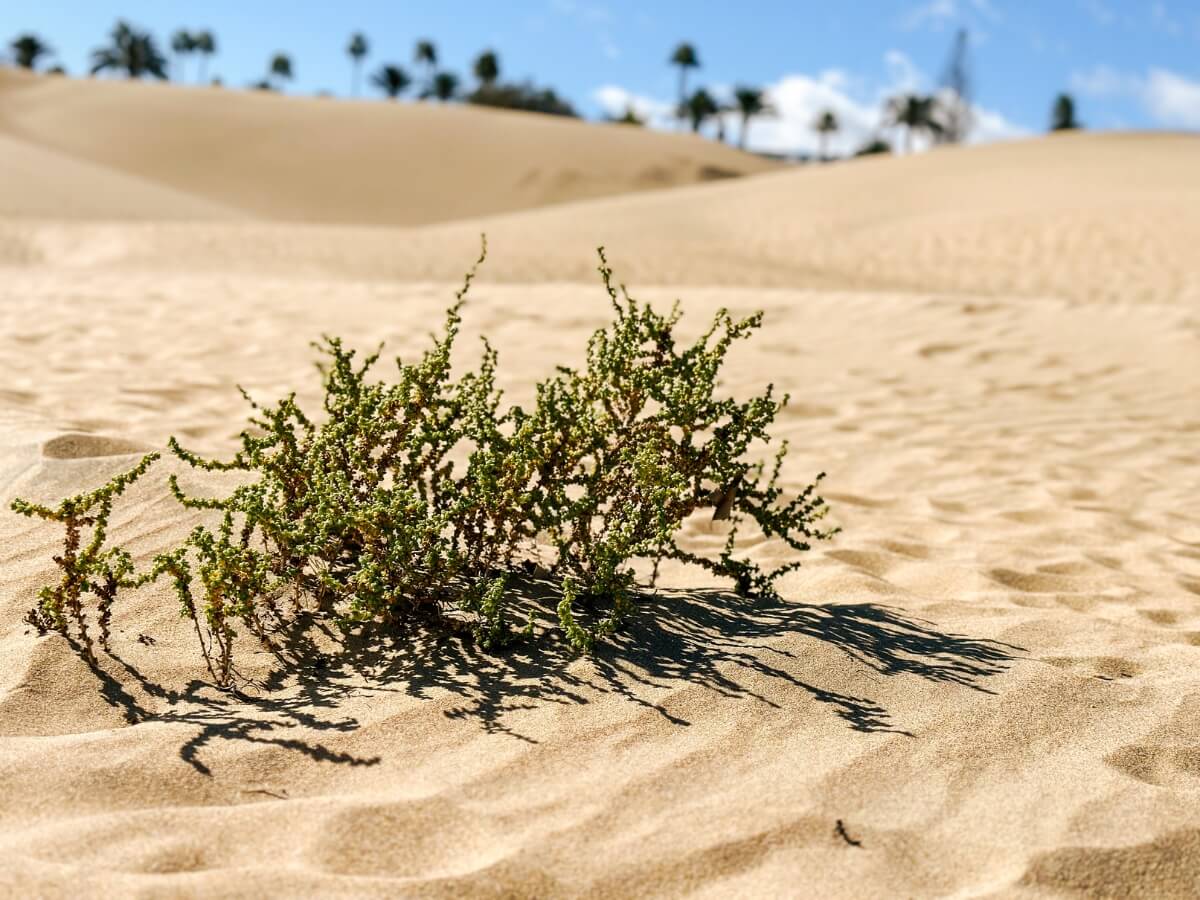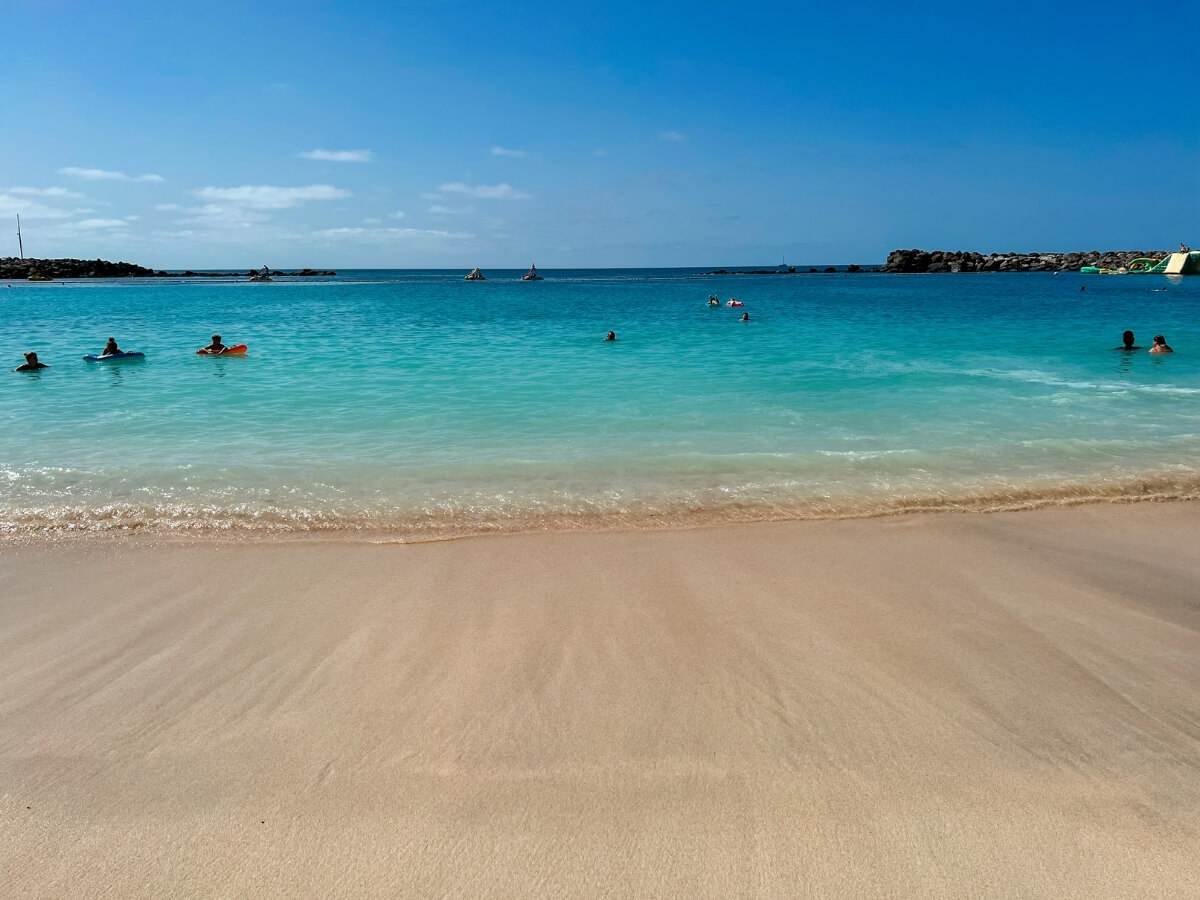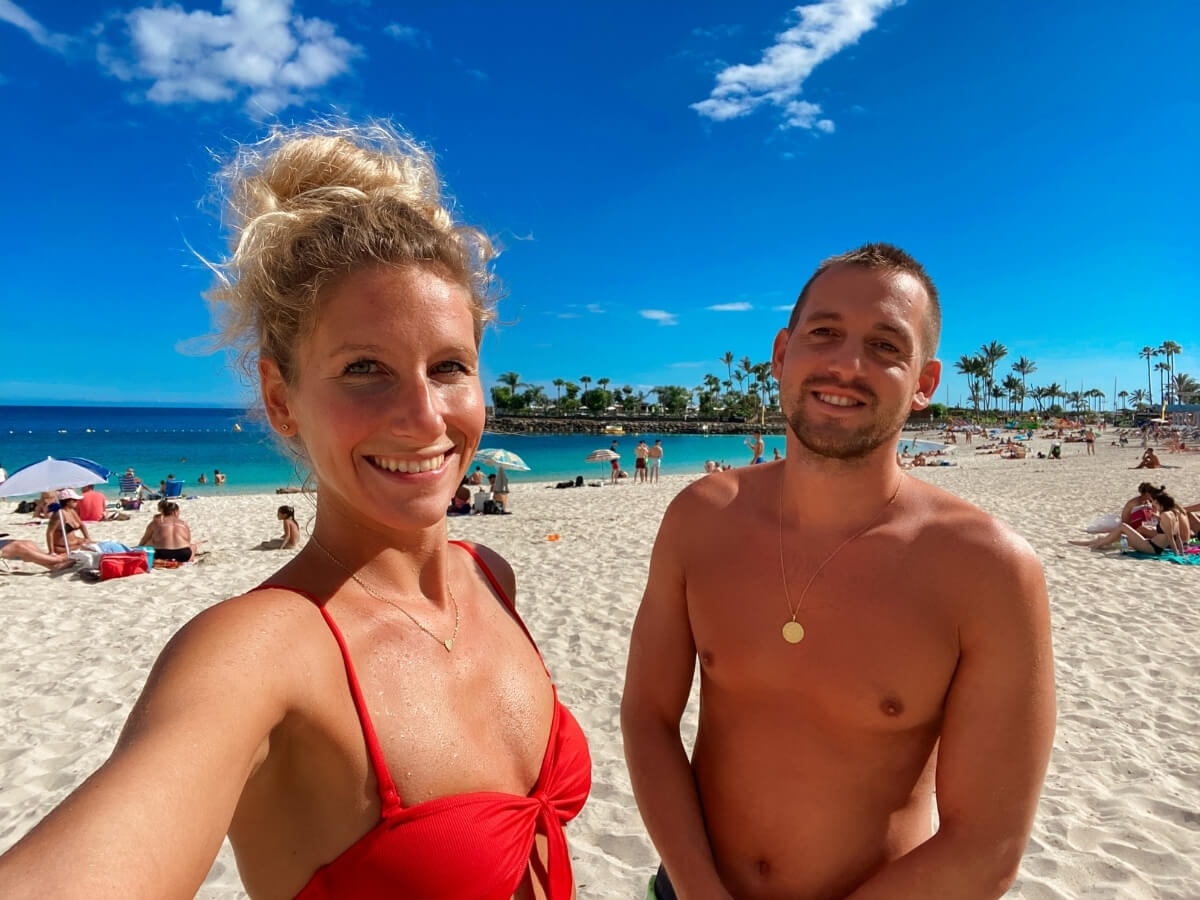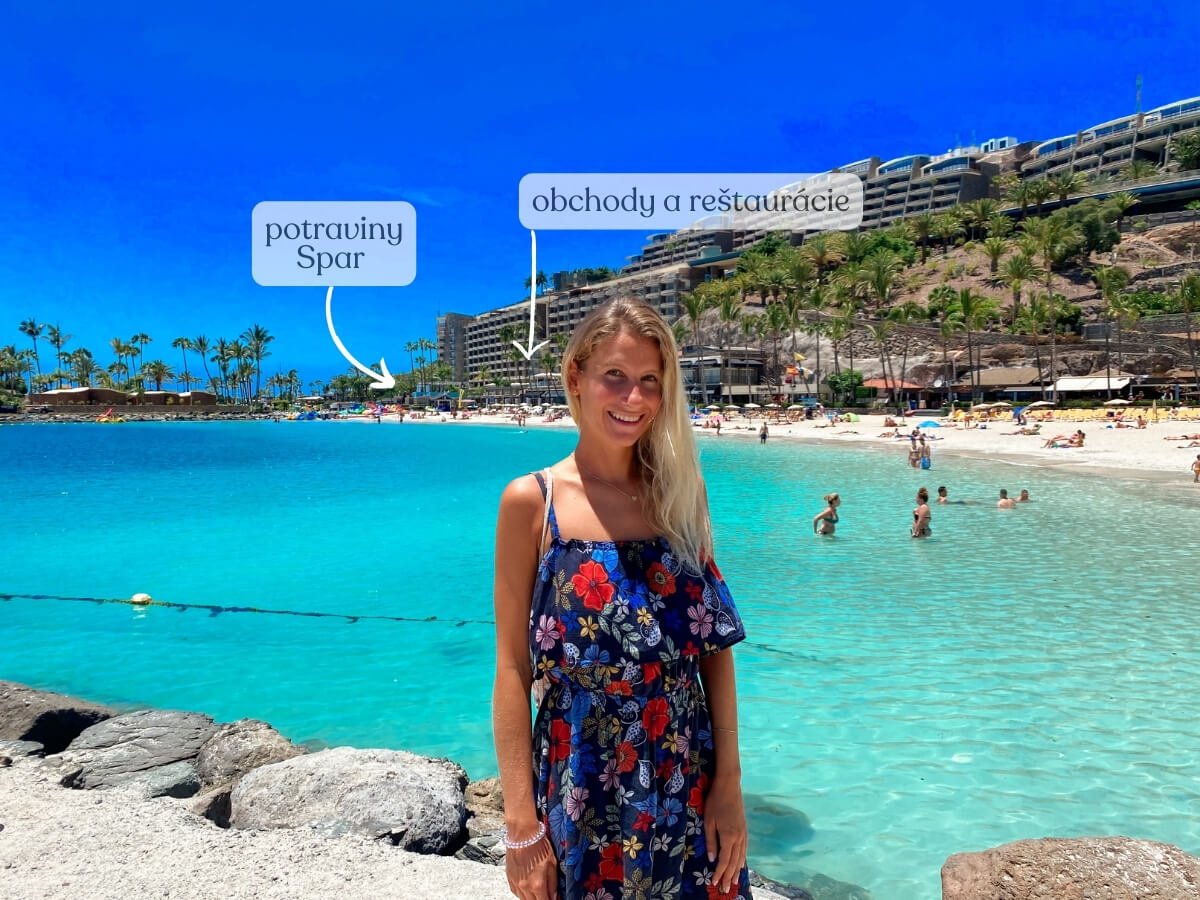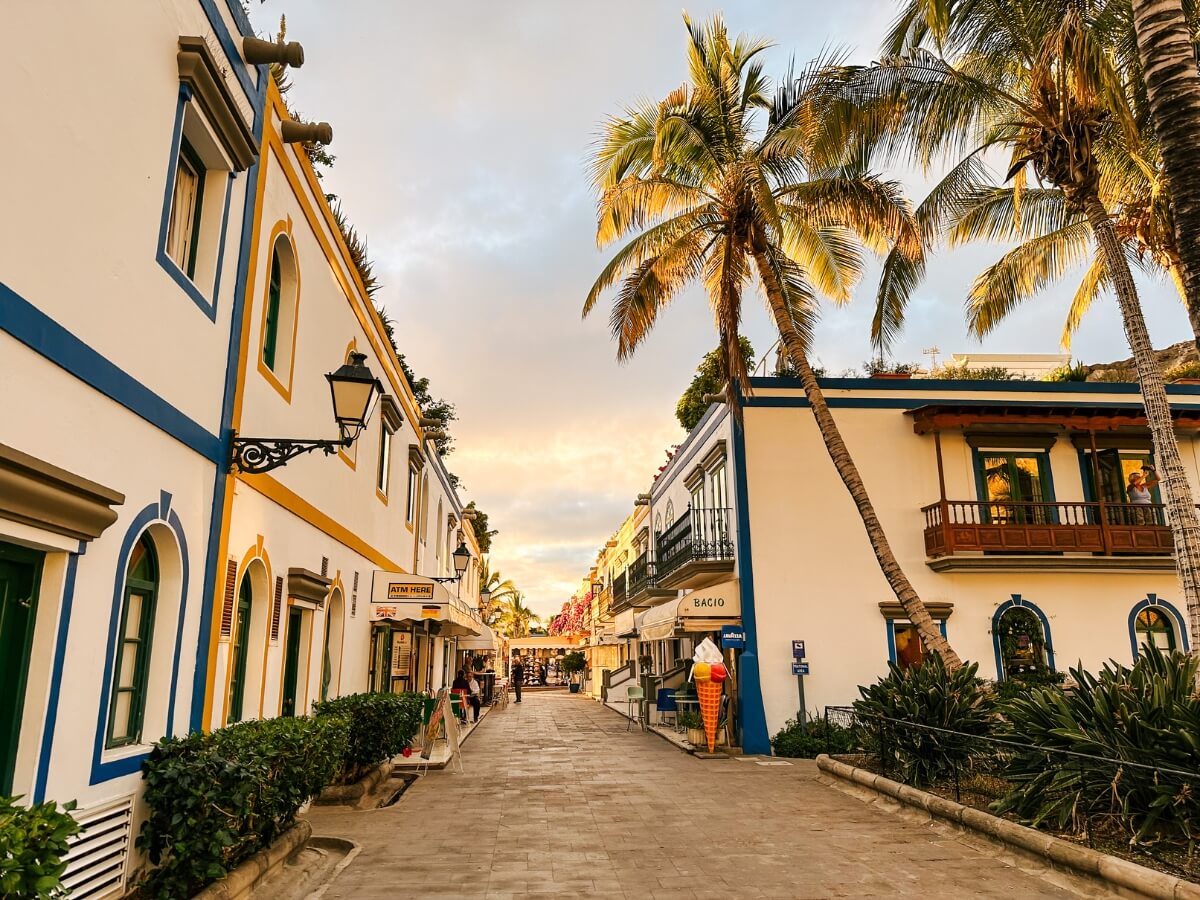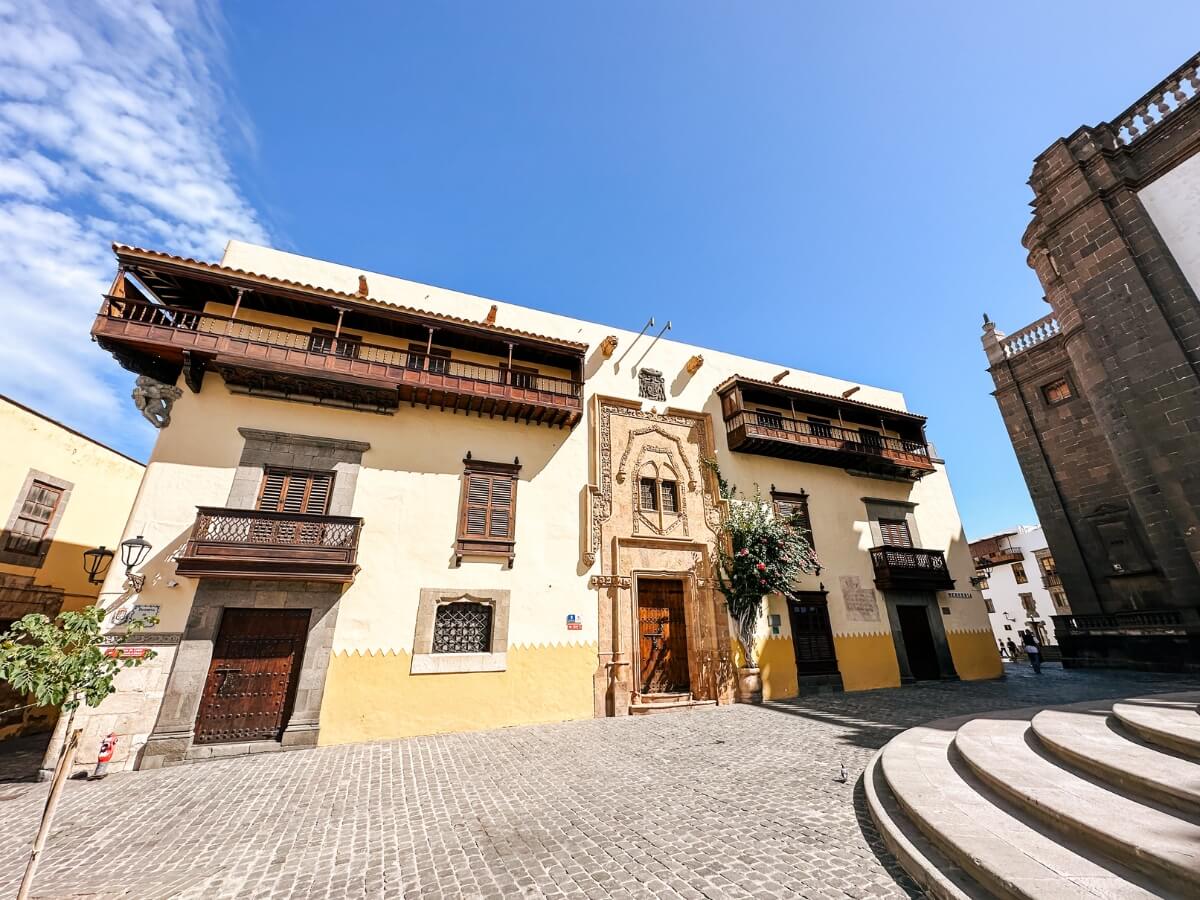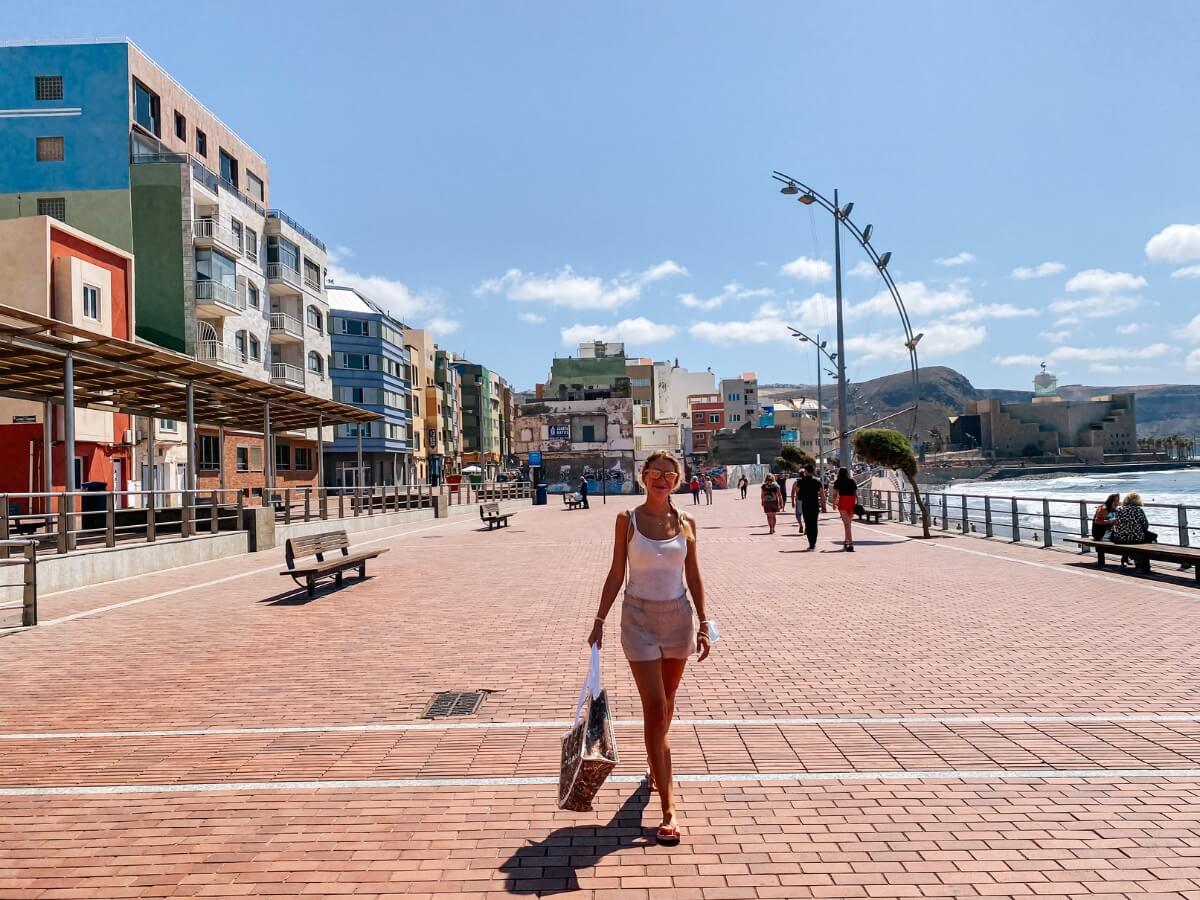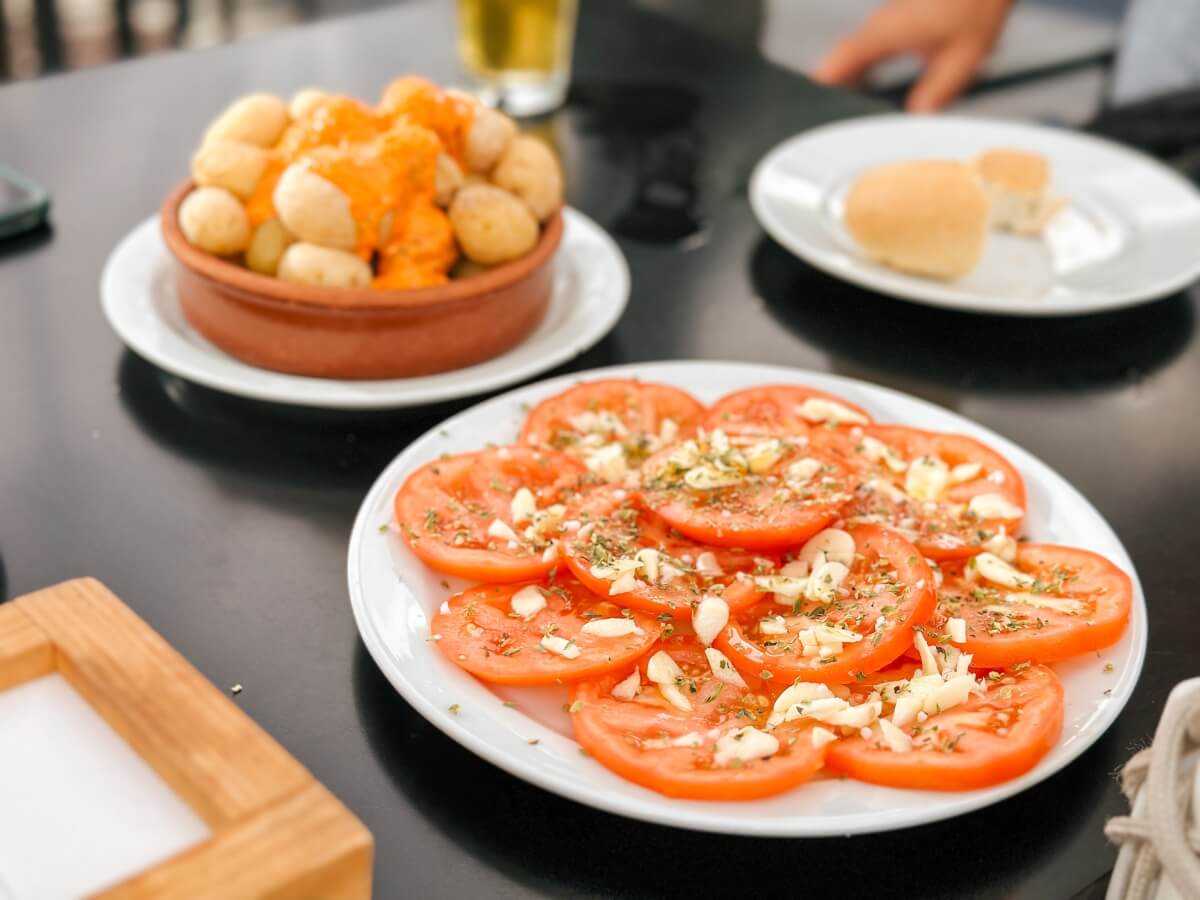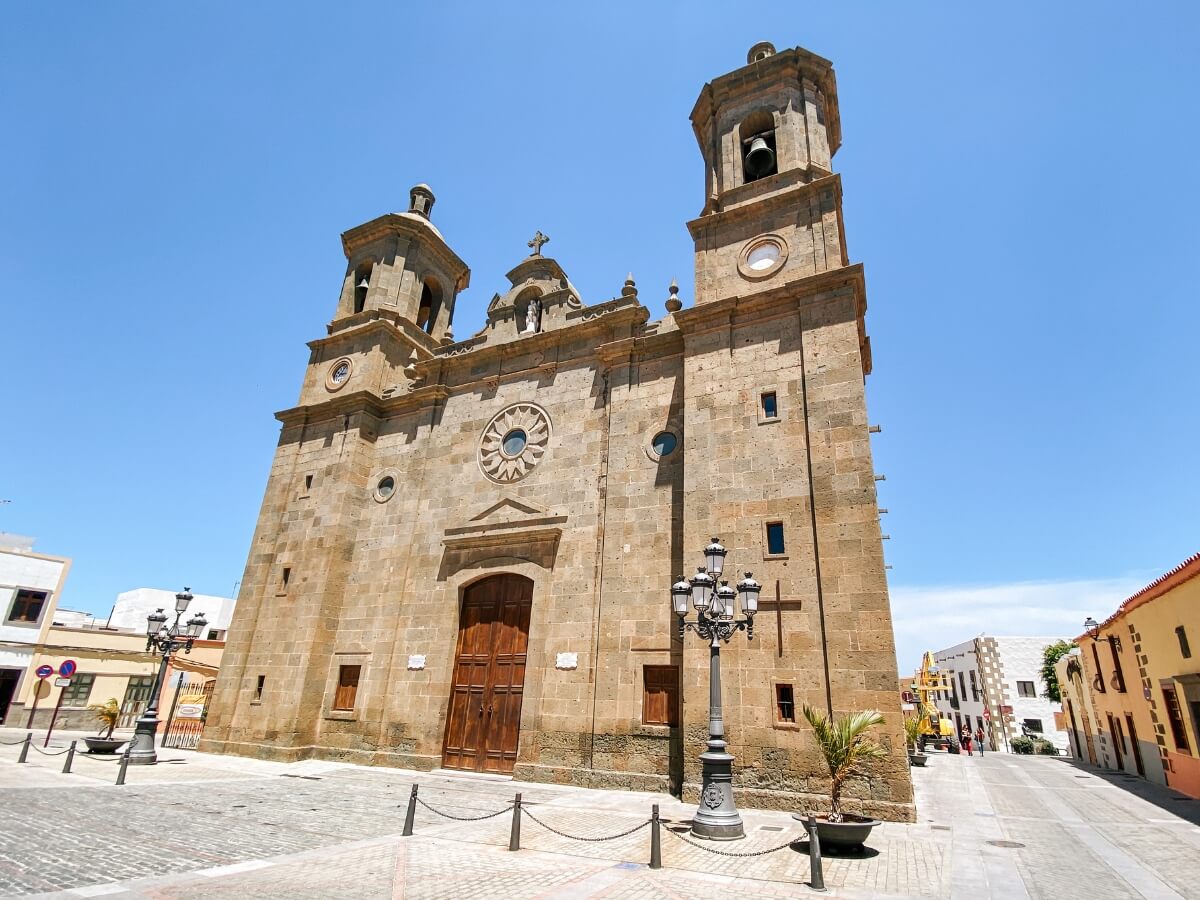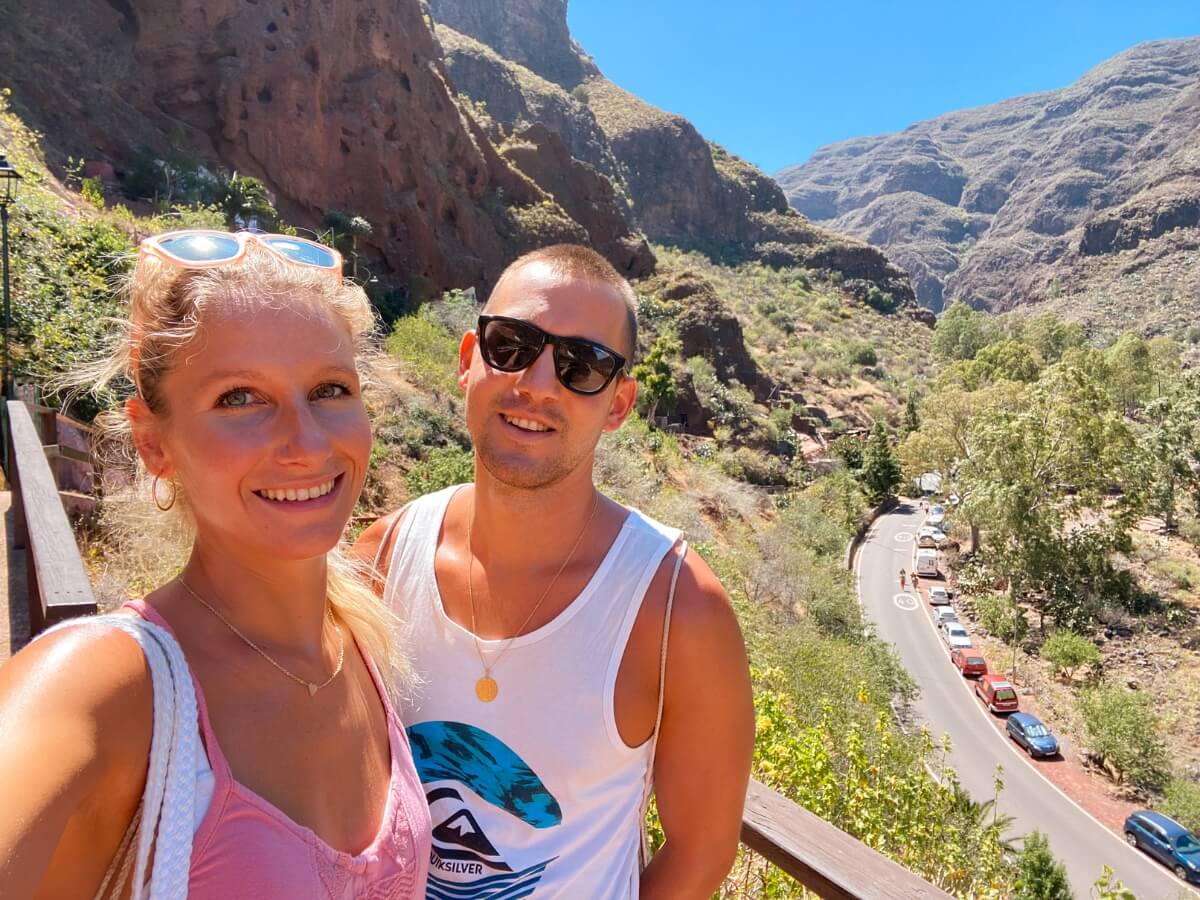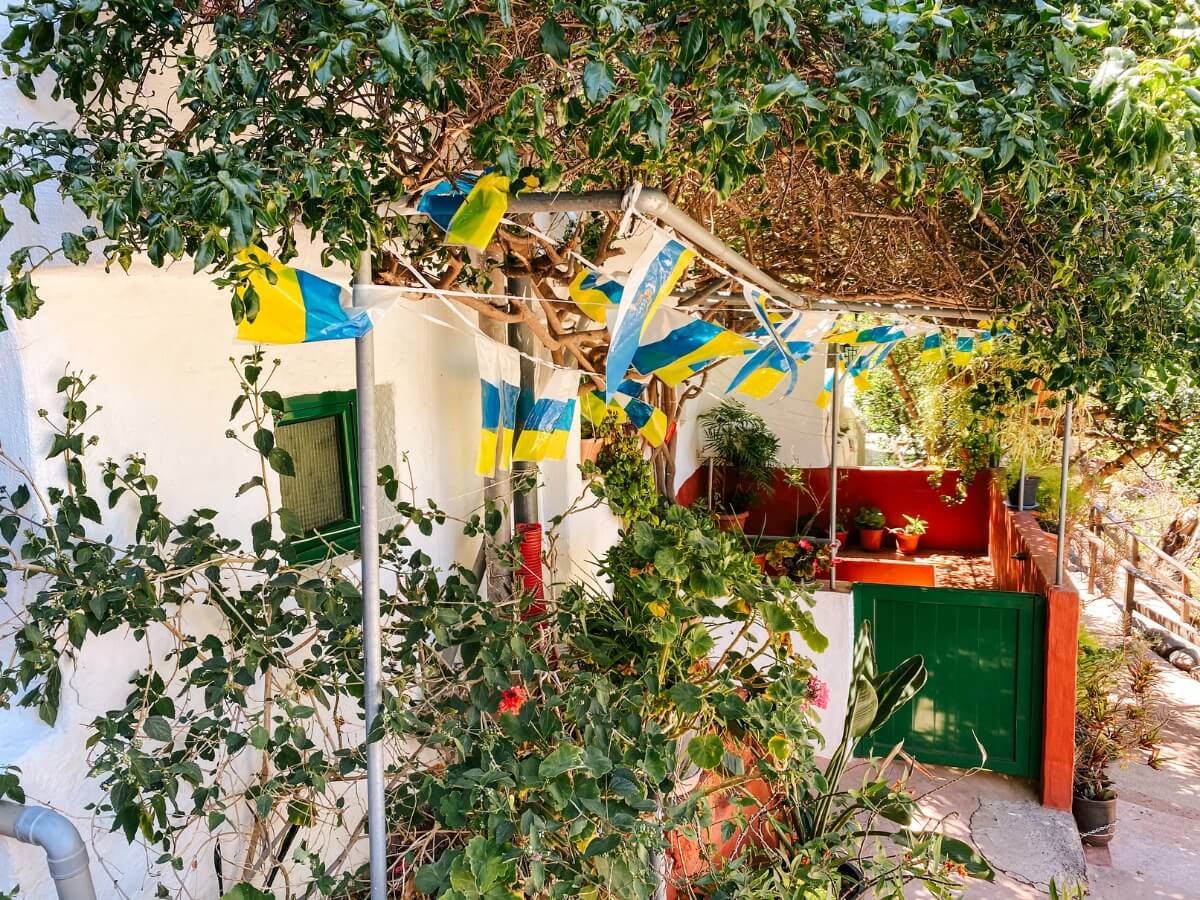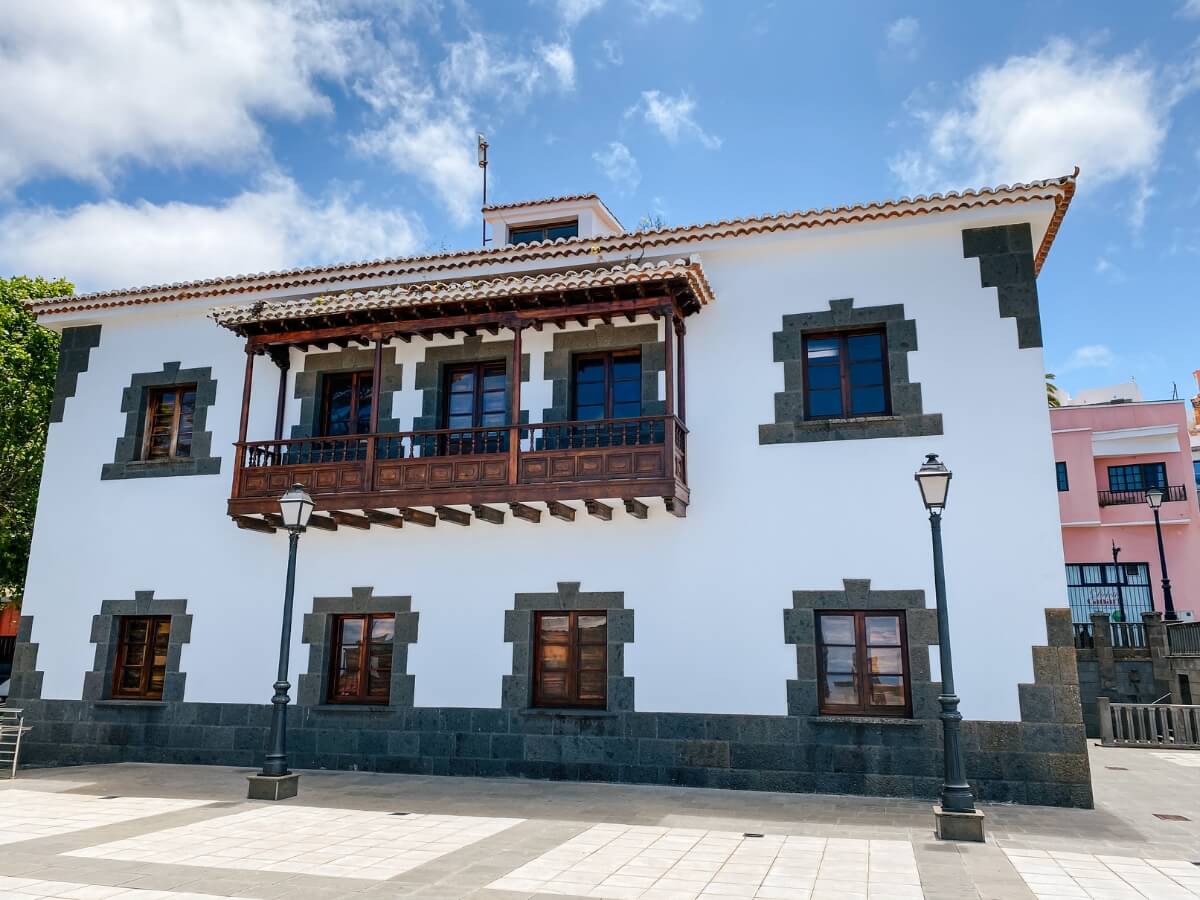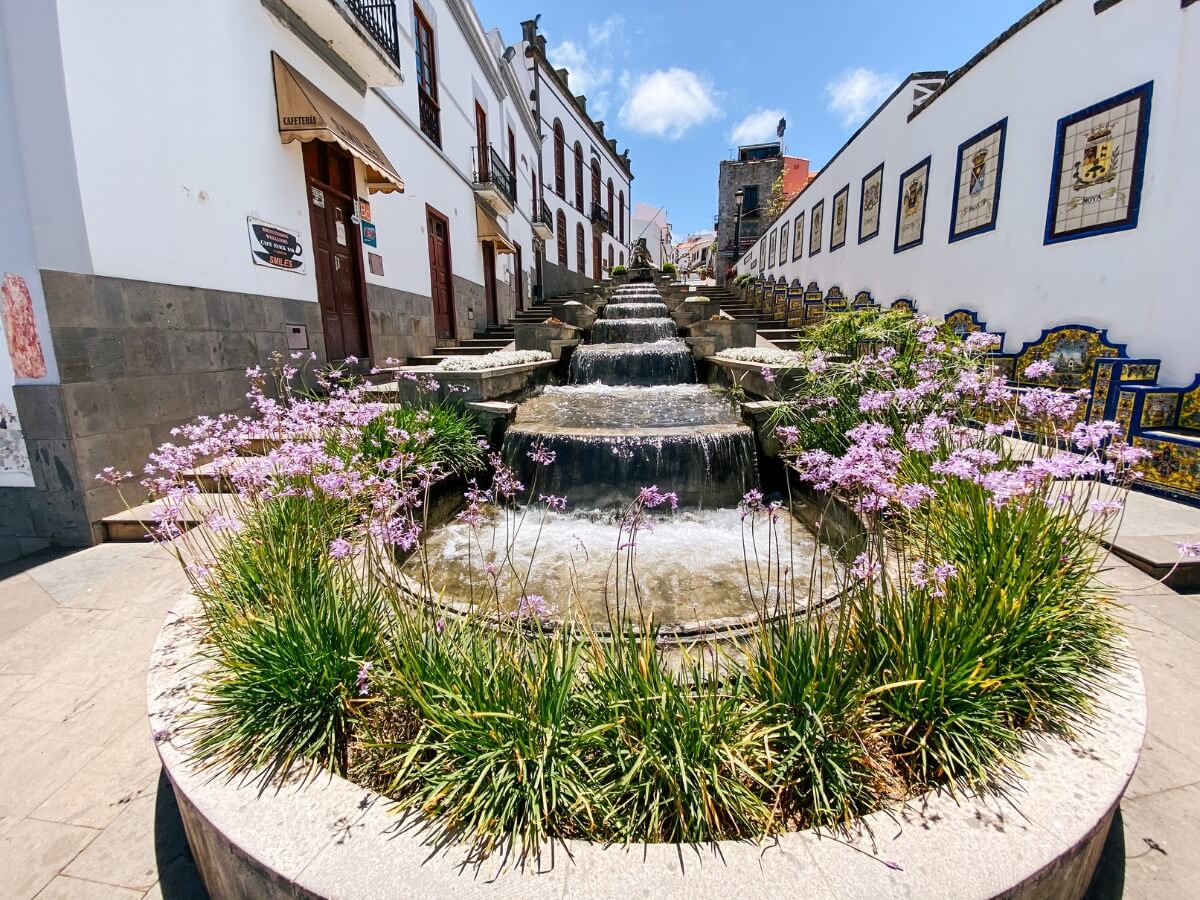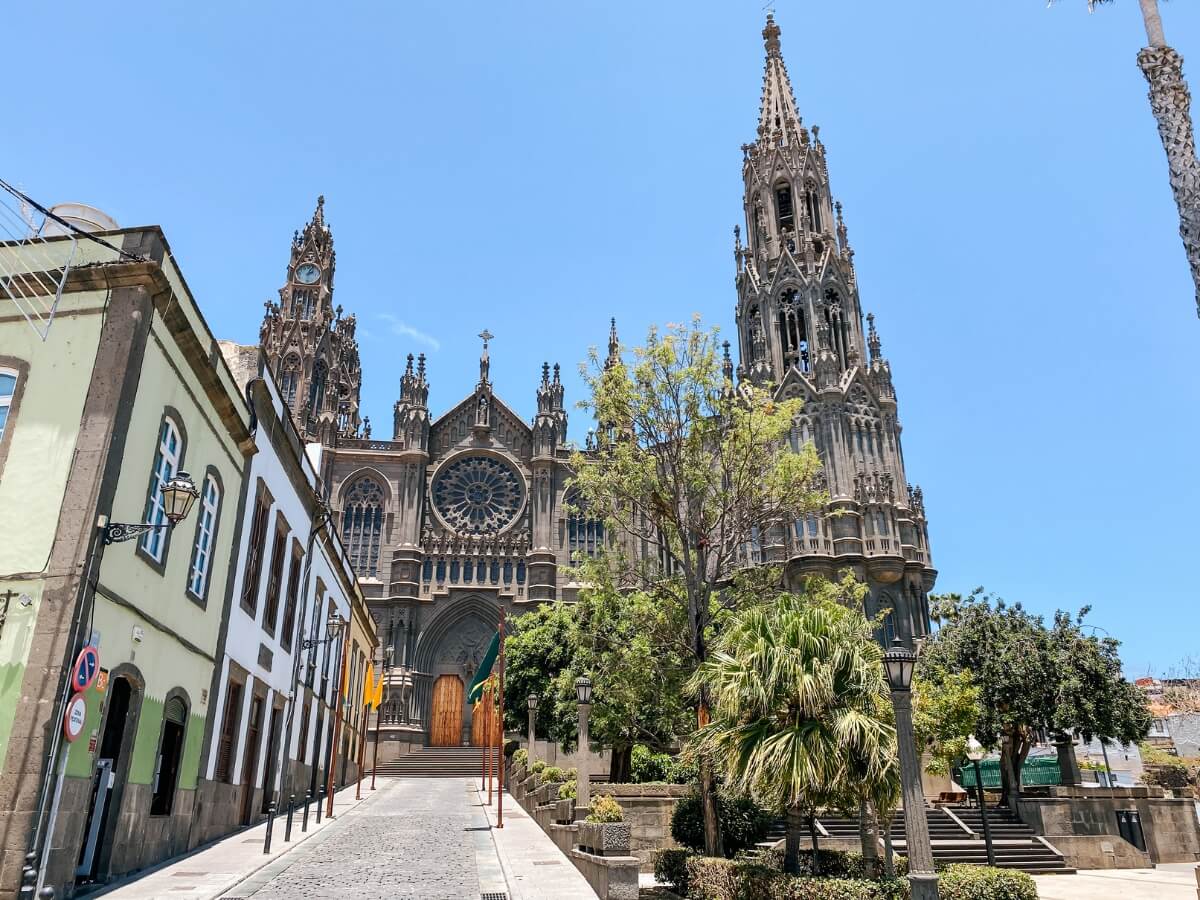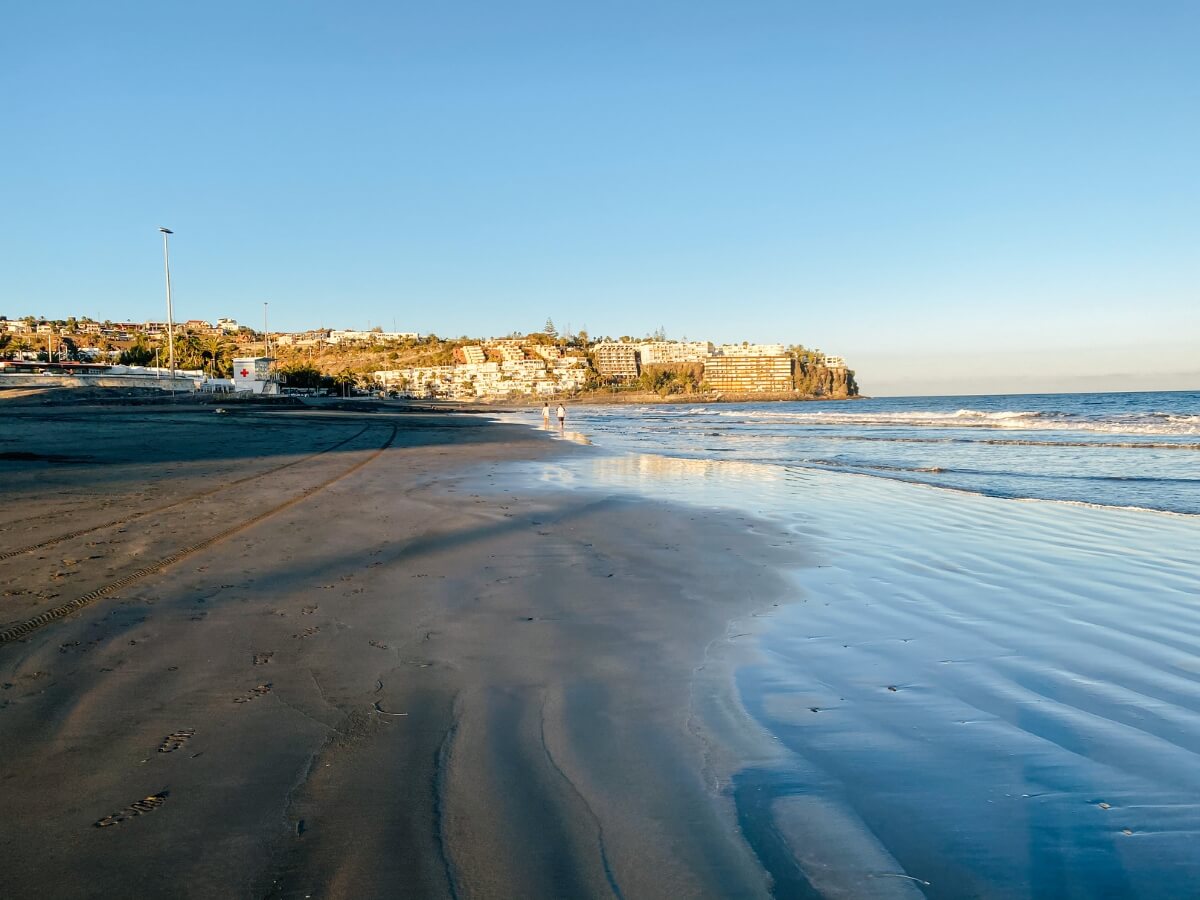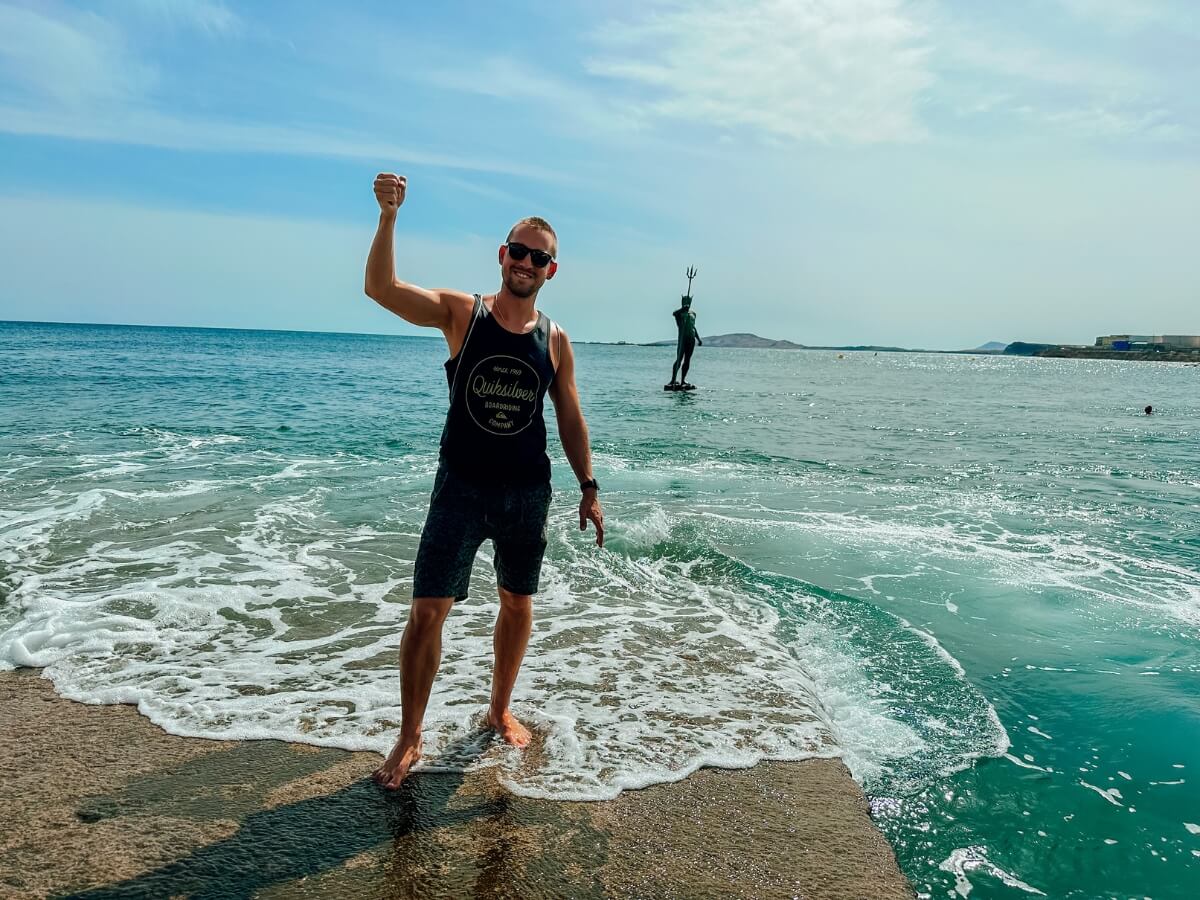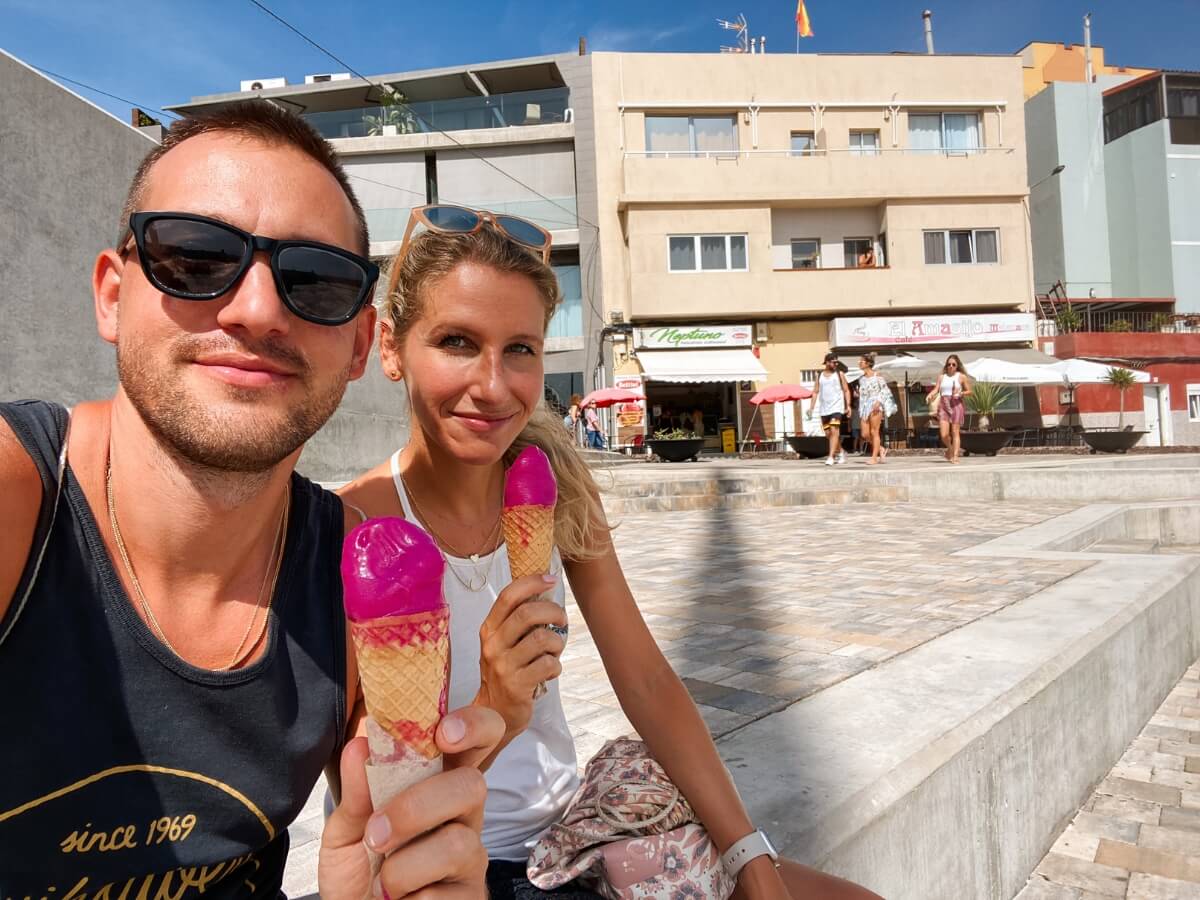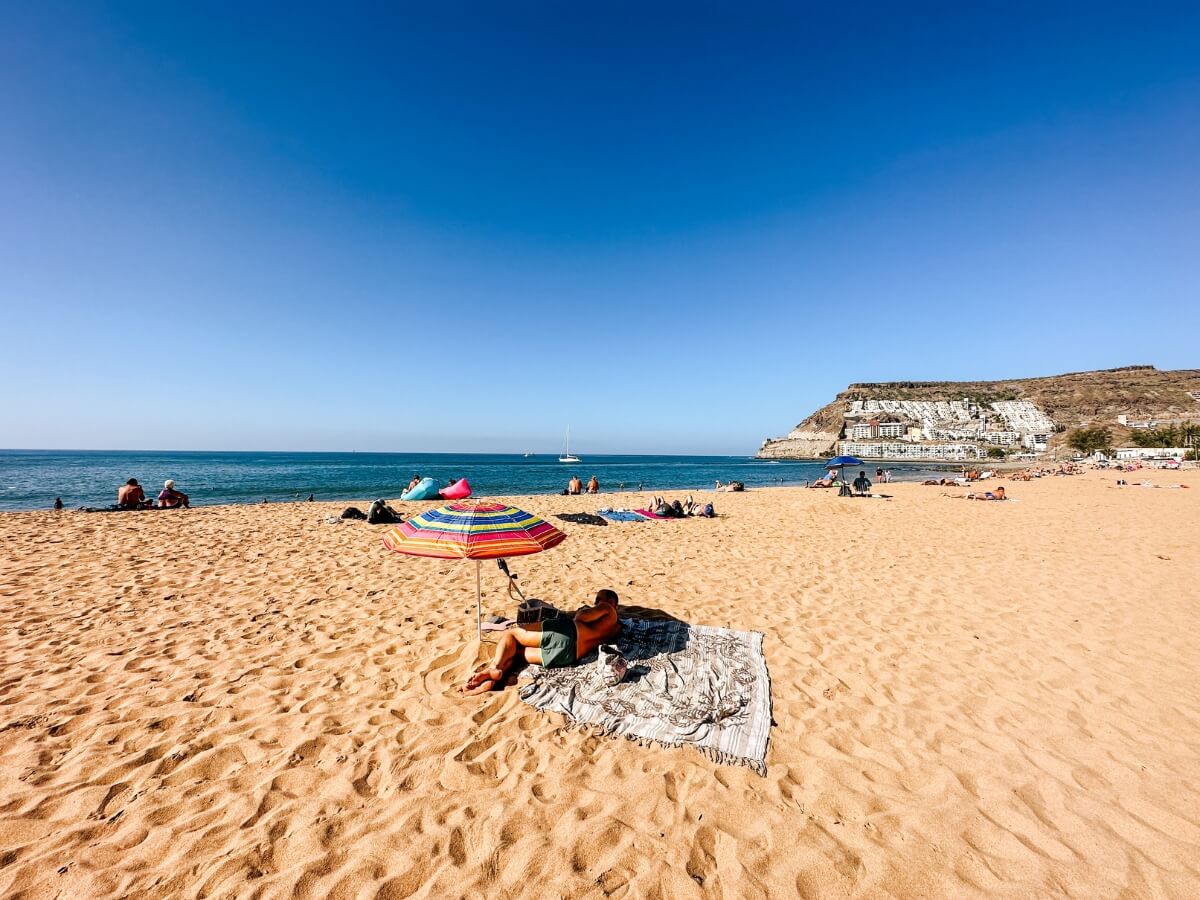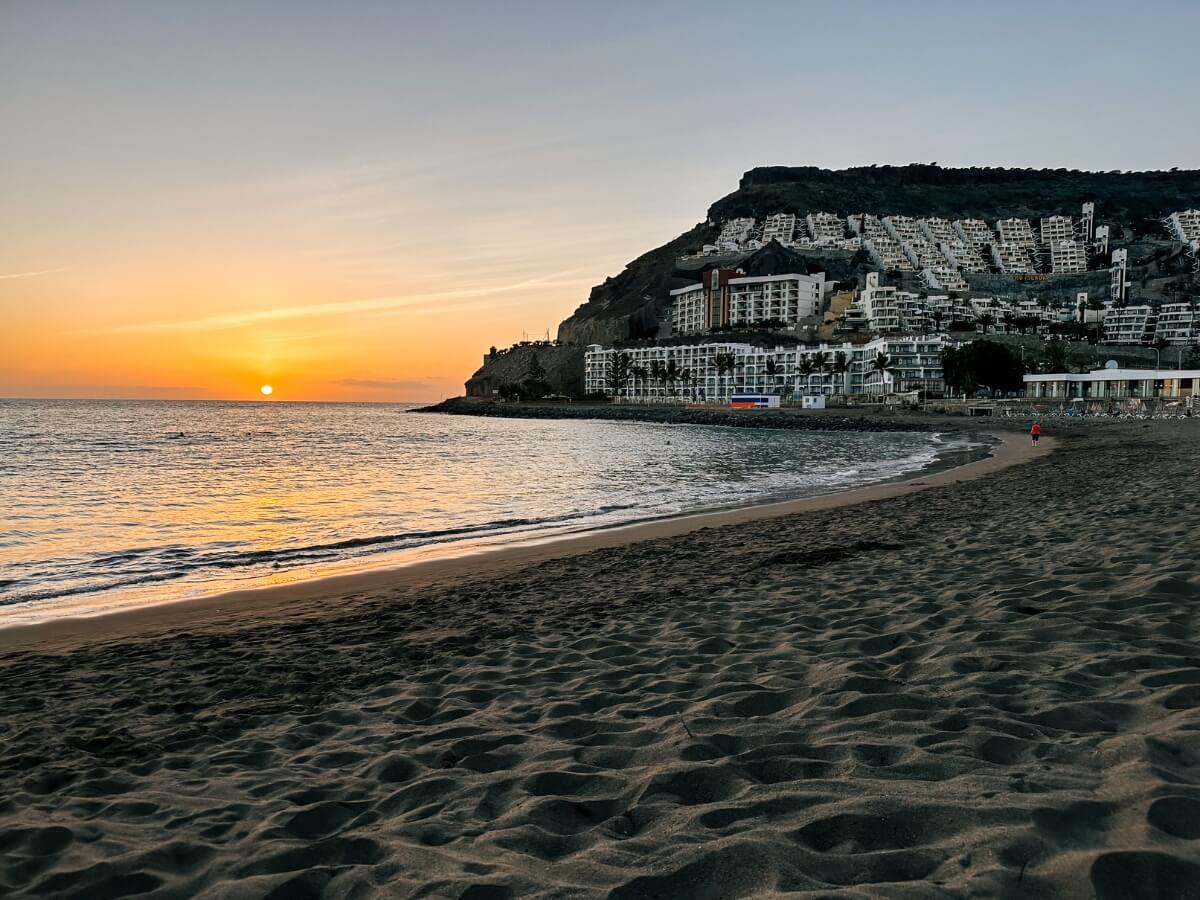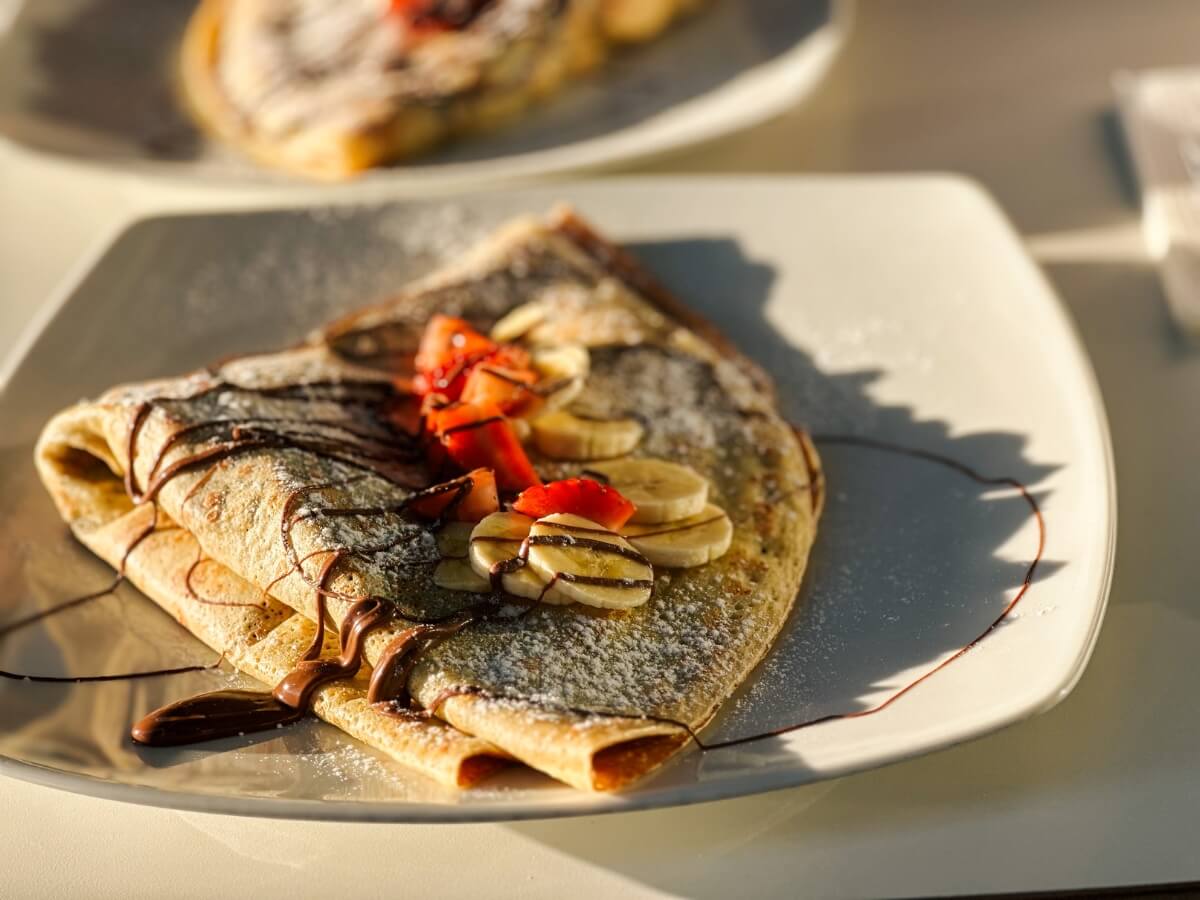If you’ve been following our blog, you’ll know by now that Gran Canaria holds a special place in our hearts. This stunning island is our favorite destination for so many reasons: breathtaking beaches, endless adventure opportunities, reliably beautiful weather, fresh local fruits, and a perfect atmosphere that keeps us coming back. Here’s why we think Gran Canaria should be on your travel list, too.
About the island
Gran Canaria is the third largest of the Canary Islands after Tenerife and Fuerteventura, with an area of 1,560 km². The capital is Las Palmas de Gran Canaria, which is also the largest city on the island. Flights arrive at Las Palmas Airport, and it takes 5 hours from Vienna. Most holidaymakers stay on the southern part of the island, where the most beautiful beaches and consistently sunny weather can be found. We also recommend this; try to find accommodation near Amadores Beach, where you’ll mostly swim, and you can reach excursions within 30 minutes.
When traveling with little ones, consider staying near Amadores Beach or Anfi Beach. These areas offer the best swimming spots for children with long stretches of shallow, crystal-clear turquoise waters, and easy access to shops and restaurants.
Weather: When to Visit
Wondering when to visit Gran Canaria? The answer is simple: anytime. We’ve found that the weather apps often don’t do justice to the island’s true climate. Our first visit was in April, and despite the apps predicting temperatures of 22 to 24 degrees Celsius, we found the days consistently warm, often hitting 28 degrees or more.
Over the years, we’ve spent anywhere from a week to nine months on the island, and our conclusion is that the weather reports must be measured in a cave! Don’t be misled by forecasts; expect plenty of sunshine and warmth throughout the year.
While July and August are reportedly extremely hot, every other month offers delightful sunny and warm conditions. Even during December to February, evenings can be a bit cooler, perfect for a light jacket, but nothing too drastic. Swimming is possible year-round, with water temperatures around 24 degrees in summer and about 21 degrees in the winter months. The refreshing Atlantic waters are a welcome relief on hot days.
What to See in 7 Days?
Just landed at Las Palmas Airport and wondering what’s next? If you’re looking to unwind for seven days straight, hop in a taxi or a comfortable bus directly to your accommodation near the turquoise waters of Amadores Beach. Here, you’ll find the perfect setting for ultimate relaxation.
However, if you’re an adventurous soul, rent a car at the airport and start your exploration immediately. Gran Canaria offers a treasure trove of experiences waiting to be discovered.
This island is a paradise for both relaxation and adventure. Whether you want to soak up the sun on idyllic beaches or embark on exciting excursions, Gran Canaria promises an unforgettable holiday experience. So pack your bags, embrace the island vibes, and get ready for a journey of a lifetime!
We highly recommend renting a car from Cicar. Based on our extensive experience, Cicar offers unbeatable value for money. We used to rent cars from Goldcar in Spain, but we often ended up paying more for insurance than the car itself. With Cicar, insurance is included in the price, and we’ve never had any issues with them (we’ve rented from Cicar more than 20 times). Renting a car for a week will cost you around €150, which includes insurance and registration for a second driver.
To make your car rental experience seamless, we’ve prepared a comprehensive guide that walks you through the entire process, from booking to pick-up and return. Check out our detailed instructions and tips to ensure a smooth rental experience.
Disclaimer: We are not sponsored or affiliated from Cicar.
We’ve explored all the local markets and grocery stores on the island, and we like to think of ourselves as experts in this area. Read our article on grocery shopping in Gran Canaria to find out which fruits and vegetables you must try, as well as our favorite local products that we buy repeatedly. You’ll also learn how to peel prickly pears and why you should definitely taste guava!
What to See in 7 Days
With a full week on Gran Canaria, you can balance beach relaxation with exciting island exploration. Spend your mornings soaking up the sun on the beach, and then set out to discover the island in the afternoons. If lounging on the beach isn’t your thing, you can explore from dawn to dusk. Many attractions are close to each other, so you can see multiple sights in a single day.
Our recommendations for must-see attractions and landmarks are divided into two parts:
- Must-See Places: These are the top spots you simply cannot miss.
- Additional Highlights: These places are also fantastic and will surely be memorable, but you can plan to visit them based on your schedule and mood.
For easy navigation, save our custom Google Map of Gran Canaria, which highlights all the places mentioned in this article.
Maspalomas Dunes
Ever wondered what it’s like to walk on the Sahara Desert? The impressive sand dunes of Maspalomas will take your breath away. Located near Playa del Inglés, this vast expanse of sand is a must-see when exploring the island. Stroll through the dunes and find the perfect spot for that unforgettable photo.
On hot days, the sand can become scorching, making it nearly impossible to walk on. We recommend visiting the dunes early in the morning to avoid the heat, and then refreshing yourself on the long beach right next to them.
Dunes are classified as a natural reserve since 1987, the dunes span approximately 400 hectares, stretching so far that you can’t see their end. Notice the green plants fenced off in some areas – they are protected species. Contrary to popular belief, the dunes are not composed of sand blown in from the Sahara Desert. Instead, they originated from the ocean floor during the last Ice Age when receding waters exposed this sandy expanse. Over time, wind carried the sand towards the shore, forming the famous Maspalomas Dunes.
Contrary to popular belief, the dunes are not composed of sand blown in from the Sahara Desert. Instead, they originated from the ocean floor during the last Ice Age when receding waters exposed this sandy expanse. Over time, wind carried the sand towards the shore, forming the famous Maspalomas Dunes.
Playa del Inglés
Right next to the dunes is the popular Playa del Inglés, a 2.7 km long sandy beach. The sea here is relatively calm, with waves becoming more suitable for surfers as you move closer to the lighthouse. The beach also has designated areas for nudists.
Faro de Maspalomas Lighthouse
Still in the same area, you can walk from the dunes to Playa de Maspalomas and the Faro de Maspalomas lighthouse. If it’s too hot, consider driving to this location. This 19th-century lighthouse stands 56 meters tall, and its light is visible up to 19 nautical miles away (one nautical mile is 1.852 meters, so 19 nautical miles is approximately 35.188 kilometers). The lighthouse emits three white flashes every 13 seconds and has been guiding ships since February 1, 1890.
While you’re in the area, take a stroll along the promenade lined with restaurants and bars until you reach La Charca de Maspalomas lagoon. This fascinating saltwater lagoon is especially popular with birdwatchers, as it hosts around 24 species of birds. Additionally, you’ll be treated to stunning views of the mountains in the background, making it a picturesque spot to relax and enjoy nature.
Beach Amadores
A signature sight – the turquoise sea and white sand!
You’ll find beaches on every corner of the island, but you can’t leave without swimming at Playa Amadores. It’s considered one of the most beautiful beaches on Gran Canaria, and rightfully so. During the season, it gets quite crowded, but due to its size, you won’t have trouble finding a spot.
Parking at the beach is free, and if you can’t find a spot, there’s a parking area near the road (above Spar). For parking directly at the beach, just be careful of side spots marked with a yellow line – parking is not allowed there. There’s also a paid underground parking lot, but we’ve never tried it. We always found a spot, sometimes needing a few tries and a bit of luck.
If you want a good swim, this is the perfect beach for you. The clear water and calm sea without waves are ideal for a few lengths of front crawl.
Since it’s one of the most popular and beautiful beaches on the island, you should expect more people. Mornings are less crowded, but the beach fills up as the day goes on. However, you can always find a spot, and we’ve never felt that the sea was crowded, even during peak season.
If you’re traveling with children, this is a must-visit. The water remains shallow for a long distance, so you can watch your little ones from the comfort of your towel or sunbed. We always bring a large beach blanket and lie on the soft sand, though not everyone likes this. At this beach, you can also rent a sunshade, sunbed, or a combination of two sunbeds with a sunshade at a discounted price.
Prices for sunbeds and sunshades (2023):
Sun Umbrella
4 €
Sunbed
4 €
Sun Umbrella + 1 Sunbed
8 €
Sun Umbrella + 2 Sunbeds
12 €
For older kids, there’s a fun inflatable world available – like a giant bouncy castle with obstacles.
Along the entire length of Playa Amadores, you’ll find a variety of restaurants catering to every taste. In the heat, we often don’t feel like eating heavy meals, so we frequently enjoyed pizza from Ciao Pizzeria. Their pizza is authentically Italian, and you can really taste the quality of their ingredients. The best part is, you can order your pizza to go and enjoy it right on the beach. When we wanted something lighter, we opted for their focaccia with tomatoes, which was equally delicious and a bit lighter than pizza.
English is widely spoken here, but if you want to impress the locals, you can say “para llevar” (pronounced “para jevar”) when ordering pizza to go.
Anfi beach
If you enjoyed Playa Amadores but want something similar yet a bit more intimate, consider visiting Anfi Beach. Parking can be a bit trickier here, but you’ll always find a spot eventually. Generally, weekends are the busiest times at the beaches, with Sundays being especially crowded. On Sundays, we recommend exploring other attractions instead of heading to the beach.
Parking Tips for Anfi Beach
On the left side, there are marked parking spots highlighted in blue, which are paid. There’s a meter on the street where you can buy the desired number of hours; a full day costs €6.
On the right side, there are free spots, though it might take a couple of tries to find an available one. If all spots are taken, there’s another paid parking lot just past the roundabout.
Parking Prices at Anfi Beach (2023):
20 minutes – 0.20 €
1 hour – 0.55 €
2 hours – 1.23 €
3 hours – 2 €
4 hours – 3 €
A full day – 6 €
Payment can be made directly at the meter, or you can download the LPA Park app, which allows you to pay easily from your mobile device by adding credit.
There are two paths to reach the beach: the high route or the low route. We recommend taking the high route for the breathtaking views. You’ll pass the Anfi apartment complex on both sides, and the view from above is stunning—think turquoise waters, white sand, and palm trees, a scene straight out of a paradise catalog. Even after seeing this view over a hundred times, it never gets old and always leaves us in awe.
On this beautiful beach, you can rent sunbeds at the same rates as on Amadores Beach. There’s also a section with more luxurious sunbeds, but be warned, they come with a hefty price tag of 20€ per bed—an extravagance we found completely unnecessary.
You won’t go hungry at this beach. The promenade is lined with numerous restaurants, and for those who might get bored, there are several shops to explore to your heart’s content. Additionally, there’s a variety of water sports on offer. Conveniently, at the end of the promenade, there’s a Spar shop where you can grab water or other refreshments.
Puerto de Mogán
The only regret we have about this town is discovering it quite late. We were always focused on the beaches and various natural attractions. We even tried to visit Puerto Mogán once, but Google Maps failed us spectacularly and led us into the hills—so be cautious.
The first time we set foot in Puerto Mogán, it was during sunset, and we were left speechless. This charming harbor town is a true gem, with its colorful houses draped in flowers and picturesque streets perfect for leisurely strolls.
There are many restaurants on the promenade, so when you are hungry, you will definitely have a choice.
El Bufadero
You can easily visit El Bufadero on your way to Las Palmas; it’s just a quick detour with ample free parking. Usually, only a handful of people are around, allowing you to enjoy this natural wonder almost in solitude. We call this phenomenon a “geyser,” even though it technically isn’t one and we will tell you why…
El Bufadero is of volcanic origin and is essentially a sinkhole or cave that fills with water according to the tides and wave strength. Compressed air then shoots out through a stone opening. You can watch this natural show endlessly, as the water doesn’t always spurt out—there has to be just the right amount of pressure. Keep your eyes open and wait for the perfect moment. The sight of water disappearing and then refilling is mesmerizing. Despite visiting countless times, we always capture its beauty in photos and videos.
Las Palmas
Las Palmas deserves its own spotlight, which is why we’ve dedicated an entire article to it, detailing all the must-see spots and tips on how to park for free in the city center. Make sure to set aside a full day for this vibrant city.
Start with the old town, Vegueta, where most of the historical sites are located.
Most attractions are within walking distance, so you won’t need to drive around. Don’t miss the Santa Ana Cathedral, the House of Christopher Columbus, Espíritu Santo Square, Santo Domingo Square, and the Mercado de Vegueta.
After exploring the historic part of Las Palmas, head north to the long Las Canteras beach. Here, you can watch surfers ride the waves and choose from a variety of restaurants along the promenade, offering everything from poké bowls to freshly grilled fish.
At the end of the promenade, don’t miss Santa Catalina Square, where you’ll find a replica of Columbus’s ship, La Niña III. We were astonished by its size and can hardly imagine how it sailed from Huelva, across the Atlantic to Las Palmas, and further to the Americas.
Piscinas Naturales El Agujero Galdar
Whether you’re a swimming enthusiast or not, this natural pool is a fantastic experience. A section of the sea is cordoned off, resembling a swimming pool. There’s no need to worry about chlorine or cleanliness—nature takes care of that with the regular influx of waves, creating a dynamic show. Just sit at the edge and watch the high waves from a safe distance.
Behind the pool, you get a great view of the colorful houses where local surfers live. You can easily spend the whole day here, watching surfers tackle each wave is an entertainment in itself. The only downside is the lack of a comfortable beach to relax on. You can lie on concrete slabs or a small rocky beach (if it’s not submerged).
If you tire of the pool, it’s just a short walk to Playa Boca Barranco beach.
Piscina Natural de Punta de Gáldar
Swimming in natural pools is a wonderful experience, so we often look for them on Google Maps during our trips. Recently, we discovered this one in Punta de Gáldar. There were only two other people, offering a private pool and a peaceful spot to relax.
Compared to the previously mentioned pool, this one is smaller and circular. The contrast between the wild waves and the calm water in the natural pool is soothing for the soul.


Agaete
Your trip to the north should culminate in Agaete, an important port town for ferries. If you’re planning a trip to another island, you’ll likely catch a ferry from here. Park at the lot right by the promenade, with a daily fee of just 2€.
Take a leisurely walk along the promenade in Agaete, with the harbor on your left and a striking line of mountains rising from the sea. In this area, you’ll also find the famous rock formation, Dedo de Dios (God’s Finger).
Continue to the right, and you’ll come across more natural pools. The path then ascends, offering stunning views of the vast ocean and surrounding mountains. On a clear day, you can even spot the El Teide volcano on Tenerife.
While in Agaete, be sure to visit Plaza de la Constitución. It’s a short walk, but if you’re already tired from exploring, you can park nearby. Adjacent to this quaint square is the impressive Iglesia Matriz de Nuestra Señora de la Concepción.
We highly recommend trying the classic dish, papas arrugadas (small salted boiled potatoes) served with traditional red mojo sauce. You can order these potatoes in various sizes; we always go for the largest plate for two people—it’s the perfect amount.
If you’re still hungry, you can always order more. Pair this with tomates aliñados—fresh local tomatoes with garlic and olive oil. Wash it down with a good beer or a radler (ask for “una Clara con limón”).
Prices (2023):
Radler – 1.50 €
Large portion of papas arrugadas with mojo – 5.50 €
Plate of tomatoes with garlic – 5.50 €
Bread – 1 €
Check out the complete menu at El Surtidor restaurant.
Agüimes
As you head towards Agüimes, you can make additional stops along the way. Visit the cave houses in Guayadeque and the lunar landscape of Barranco de las Vacas. A quick stroll through Agüimes is enough to soak in its charm. Don’t forget to take a photo with the camel statue, a popular postcard image.
This quaint town is characterized by its narrow streets and colorful houses.
In the historic part of Agüimes, you can’t miss the parish church of San Sebastián, a quintessential example of neo-classical architecture in the Canary Islands.
Guayadeque
Just 3 km from Agüimes, you’ll find the stunning Guayadeque Ravine. There are several trails to explore, so you can choose based on how much time you have and how far you want to walk. This lush green ravine forms a natural boundary between the towns of Agüimes and Ingenio and is one of the largest ravines in the Canary Islands. Interestingly, you can see over 80 species of plants that are endemic to this island and found nowhere else in the world.
Don’t be startled by the rustling leaves or other sounds during your hike—large lizards inhabit the area. They love to bask in the sun but will scurry away before you can snap a photo.
If you’re looking to maximize your day, you can simply park your car here and immerse yourself in nature. However, the cave houses are an even more fascinating aspect of this place. The first inhabitants of Gran Canaria lived in this ravine. To survive, they built their homes higher up and settled in caves, where they found peace and shade. A small stream at the bottom of the ravine was their only water source at the time.
When we visited the museum in Las Palmas, we discovered that many archaeological finds came from this area. Living in cave houses has persisted into modern times, and you’ll see several colorfully decorated homes. If you want to experience this unique way of living, there’s even a cave hotel you can stay at.
Barranco de las Vacas
Known as the “Moon-like Landscape,” this spot is perfect for those who love unique natural formations and stunning photos. If you’re familiar with the colorful Antelope Canyons in the USA, Barranco de las Vacas offers a similar experience, though on a smaller scale. The distinctive rock formations, called Tobas de Colores, are a must-see during your trip to Agüimes.
This part of the ravine is relatively small, and the experience can be less enjoyable if crowded. We recommend visiting during the week, ideally in the morning, to avoid large groups of tourists.
Salinas de Tenefé
Visiting this saltworks will help you understand why the fairy tale “Salt More Precious Than Gold” rings true. We recommend arranging a guided tour in advance. We’ve visited multiple times, and each time, one of the owners provided fascinating insights into the salt-making process and the healthiest types of salt.
This place is one of our favorites, so much so that we wrote a separate article about the island’s salt.
Roque Nublo
In the Tejeda region lies one of the world’s largest cliffs, Roque Nublo. This volcanic monolith stands at 1,813 meters above sea level. Declared a protected area in 1987, it is the third-highest point on Gran Canaria.
The highest point on Gran Canaria is Morro de la Agujereada (1,956 m), followed by the well-known Pico de las Nieves (1,949 m).
Reaching Roque Nublo by car is straightforward, but prepare for winding roads as you ascend. Although I often get car sick, this trip was manageable—even without motion sickness medication. A mid-journey stop to catch your breath can make the trip more comfortable. Several viewpoints along the way also break up the drive nicely.
Parking is easy, and the trail to Roque Nublo starts right from the main road, with a length of about 1.5 km. You’ll be greeted by the sight of Roque Nublo (translated as “Cloud Rock”) and the adjacent Roque de la Rana (“Frog Rock”). For those up for a longer hike, there’s a 5 km trek that offers views of the Las Niñas, Chira, and Soria reservoirs.
What Next? 🙂
The landmarks, attractions, and beaches we’ve mentioned are must-sees that you shouldn’t miss during your visit to Gran Canaria. If lounging on the beach isn’t your only goal and you want to make the most of your trip, there is so much more to explore. Even though we’ve visited several times, we still haven’t seen everything the island has to offer. Here are more recommendations based on our experiences.
Teror
Step into history and admire stunning architecture in Teror, one of the oldest towns in the Canary Islands. Don’t let the name mislead you; it has nothing to do with terror.
The symbol of Teror is the Basilica of Our Lady (Basílica de Nuestra Señora del Pino) and its charming streets lined with colorful houses adorned with wooden balconies carved from local pine trees. This neoclassical church, built in the 18th century, boasts numerous artworks, including statues, paintings, and marble fountains. Teror is also a significant pilgrimage site following the apparition of the Virgin Mary on September 8, 1481.
Firgas
If you’ve been on the island for a few days, you’ve likely bought Firgas-branded water at the supermarket. Welcome to the town of water, Firgas. The town center features a beautiful waterfall! The main attractions are two decorated walkways: Paseo de Gran Canaria and Paseo de Canarias. Paseo de Gran Canaria boasts an impressive waterfall flanked by tiled benches with the 21 coats of arms representing all the municipalities of Gran Canaria. On Paseo de Canarias, you’ll find statues and coats of arms of all the Canary Islands.
Everything in Firgas is within walking distance, including Plaza de San Roque with the San Roque Church. This square offers breathtaking views; on a clear day, you can see the neighboring islands of Fuerteventura and Tenerife
Arucas
Near Firgas is another great stop: the town of Arucas. When we think of Arucas, two things immediately come to mind: rum and the cathedral.
Arucas is known as the town of rum, home to the Canarias Rum Distillery. We highly recommend visiting the rum factory and taking a tour, where they will show you how the rum is made and stored, ending with a tasting session. There is also a shop where you can buy rum at better prices than in regular stores. A great feature is that they have many mini bottles, so you can bring home liquid souvenirs.
The San Juan Bautista Cathedral, built between 1909 and 1917, slightly reminds us of Notre Dame. It’s truly beautiful, so make sure to stop by and admire its beauty. The detailed architecture always fascinates us.
Gáldar
While in the north and heading to Agaete, make sure to stop in Gáldar. Right in the center, you’ll find Santiago Square with a fountain and a church. There are many restaurants around the square, but the best thing you can do is just wander around the town and its streets. Take a stroll along the long Calle Capitán Quesada. Gáldar is also a known pilgrimage site, where the Way of St. James ends (starting at the lighthouse in Maspalomas).
San Agustín
San Agustín is our beloved place where we always feel at home. We spent almost a year here and always returned when we stayed on the island for a longer period. When you ask the locals which beach is their favorite, most will say San Agustín. The locals don’t like artificial beaches filled with tourists and shops; they prefer natural beaches.
This town is very calm and quiet, and what we love most is the promenade along the sea. From San Agustín, you can easily walk to the dunes.
Melenara
On your way to Las Palmas, you can relax on the beautiful beach in Melenara, guarded by a statue of Neptune. Neptune is the god of the sea, known as Neptune in Roman mythology and Poseidon in Greek. We visited when the sea was calm, but when the sea is rough and waves crash against the statue, Neptune looks like a true sea guardian.
You can rest and swim at the smaller Playa de Melenara beach, which has dark sand and basalt rocks on the sides. Right by the beach are several restaurants with sea views.
Botanická záhrada
The Jardín Botánico Canario Viera y Clavijo is a must-visit when heading north, whether to Las Palmas or Agaete.
The entrance is free, which surprised us after visiting. When we read that there was no entrance fee, we imagined a smaller garden with a few palm trees and flowers. We didn’t expect to step into a vast botanical garden that amazed us at first sight. We learned that this botanical garden is the largest in all of Spain.
Explore the extensive collection of palms from around the world, and then take the steps into the depths and heights of the garden, where you will be greeted by twin dragon trees and stunning views of the entire garden. It’s hard to describe, but the view is fantastic.
Playa Tauro
When you are at Amadores Beach, you can walk to the nearby Playa Tauro. It’s a natural beach with more orange-colored sand. There is a small restaurant with a bar where you can enjoy a beer while watching an undisturbed sunset.
There is more space than at Amadores, so you won’t feel crowded even in peak season, and you can find a separate spot to relax and sunbathe.
Warning: The waves at this beach are often very strong and subtle. They may seem harmless, but they can be quite powerful. Observe the situation and gradually cool off in the water.
Playa del Cura
A few steps further is Playa del Cura, a smaller beach near a hotel complex. We love this beach as well; it’s peaceful, great for swimming, and the waves are usually not very strong. A little farther from the beach (a max 5-minute walk) is a small Spar shop and a few restaurants where you can buy snacks or pizza to enjoy on the beach.
Prices for Sunbeds and Umbrellas (2023):
Sun umbrella
3.50 €
Sunbed
3.50 €
Sun umbrella + 1 sunbed
7 €
Sun umbrella + 2 sunbeds
10.50 €
Puerto Rico
After swimming and sunbathing at Amadores Beach, you’ll likely be hungry. That’s the perfect time to head to Puerto Rico for a nice dinner, just around the next bend. It’s a 5-minute drive with parking. We often preferred walking after lounging on the beach; it’s a lovely walk along the promenade with sea views.
The town welcomes you with white houses, a long street, and a harbor with a beach.
Head straight to the Mogan Mall, where any of the restaurants is excellent.
Our favorites are the Italian Vinci’s, Indian Taj Palace, and for the best pancakes or waffles, +Di un Gelato.
Fuente de Los Azulejos
We first encountered the word “azulejos” in Andalusia, especially in Seville, where these beautiful, colorful tiles are abundant.
The name for these rocks is truly fitting, as they are interestingly colored and unlike anything we’ve seen elsewhere.
The road to this spot is winding, but the trip is worth it because you can stop several times along the way to enjoy breathtaking views.
These colorful rocks formed 13 million years ago at the summit of a volcano. Their vivid hues are due to a combination of superheated steam and gases reacting with the iron content in the stones. While you’ll see many green rocks in the area, these rainbow-hued rocks right by the road are the most striking and breathtaking.
Cactualdea Park
If you’ve managed the winding roads to the colorful rocks, go a little further to visit Cactualdea Park. This cactus park is the largest in Europe, home to over 1,200 different types of cacti.
Make sure to allocate at least an hour for this visit. Besides the vast array of cacti, there are also a few animals. At the entrance, you can buy food to feed the local peacocks and ducks, which will follow you around like your best friends. You’ll also see turtles and donkeys.
The vast number of cacti and the stunning views of the surroundings were soothing for us. If you haven’t been to a similar park, this place is definitely worth a visit.





